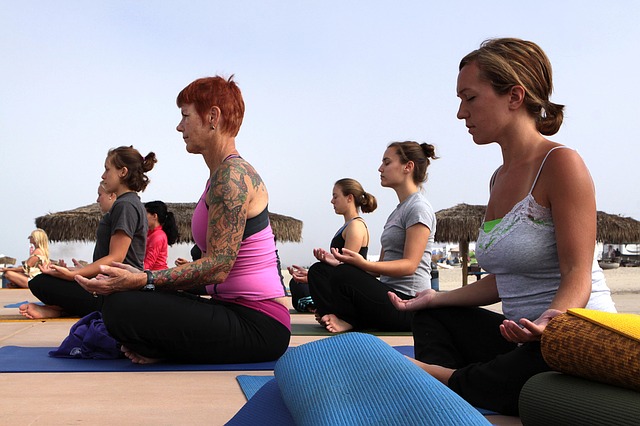
While practicing yoga using DVDs and internet videos is wonderful for beginning and establishing a yoga routine at home, attending a yoga class can be quite rewarding and is highly encouraged.
Although there will be more people than just yourself in a class, yoga instructors are able to be mobile and give one-on-one attention as needed during a class.
At a studio, you can ask questions and receive minor adjustments that you may not have gotten from the reflection in your TV. It’s always nice to know that you’re not alone in something, and when you sign up for a beginner-level class, you know you’re amongst yoga peers. Having a teacher in front of us is a richer resource than many of us realize when we start on this journey.
For the novice yogi, the thought of attending a yoga class for the first time can be both exciting and terrifying. There is often a lingering seed of doubt where we may question our confidence in our knowledge of Sanskrit words and names of poses, if our new yoga pants really are moisture-wicking, or if “extra bean” was a good choice last night. Do not feel alone in having these types of reservations—there is a good chance many others on the mats next to yours are having similar thoughts and concerns during their first studio classes too.
I’ve compiled a brief list of pointers and suggestions to help rest your worries and give you the final nudge to get into a studio:
1. Take the plunge and sign up for a class.
If cost is an issue, many studios offer “new student” specials giving prospective students the opportunity to attend a certain number of classes over a certain amount of time at a discounted rate to see if the studio is a fit. I would suggest checking the schedule to see if any beginner or slow-flowing classes are offered and consider giving one a try. That way, you won’t have any obligations if you decide you would like to continue your search, and you may even be able to try out a few different styles of yoga along the way. Or, you may end up loving it and making a bunch of new friends!
2. Pack your bag.
Knowing what props to bring to a yoga class may seem like a mystery to some, but let it be no more. Novice yogis may not have and may be intimidated by, the various props used in yoga. Do not feel the need to bring your entire arsenal of yoga props; I have never attended a class that required students to use props that were not provided. Some people prefer to bring their own mats, blocks, and straps, but studios generally provide all of these for student use (and if there were to be a fee, it is usually absorbed into the cost of the class). You can always call the studio ahead of time and see what they have in-house for students to use.
I always make sure to take a bottle of water and a small towel in case I work up a sweat. Wearing comfortable clothing is key as to not distract your mind and allow for a full range of movement. Please refrain from wearing any strong perfumes, lotions, or body oils as this may create a mental and sensational distraction to yourself and others in class.
3. Degree of flexibility does not equal degree of success.
It’s not about whether you can touch your toes or your head to your shins; it’s about whether or not you show up to class. On the scale of “straight as a board” to “human paper clip,” everyone falls somewhere different—somewhere that is correct for them right now.
4. Maintain focus and attention during class.
As a new student, it is easy to get distracted by seeing others in poses in front of your eyes or in the mirrors. When we’re able to see others in poses, we take mental notes to use when stretching and bending our bodies into the same poses. It gives us a point of reference for our own bodies and practices.
That said, yoga is a practice of attention and focus, and it’s important to remember that if people are looking at you, they’re probably making sure they’re in the pose correctly, or they’ve focused their mind and attention elsewhere and were in a blank stare. Don’t let yourself be distracted by someone’s gaze, and try your hardest to stay within your own focus.
If something distracts you (someone messes up, the music doesn’t cooperate, or someone’s bodily function catches your attention) take 8 to 10 breaths to re-center and refocus, and help ease yourself back to where you were in your flow.
5. Repetition and practice is key.
Over the course of establishing a yoga practice, students will be exposed to lots of vocabulary, all of which will be very useful on their yogic journey. Just like learning a new language, learning the names of the yoga poses, key terms, and important people/figures will take time and practice, but it is incredibly useful and highly recommended. New students are not expected to know the names of poses, and teachers will oftentimes uses both English (or whatever native tongue is spoken where you are) and Sanskrit names during class.
If students are looking to establish a solid yoga practice, I suggest spending some time learning the names of the poses. Knowing the names of the poses allows for a smoother flow and the ability to maintain your state of mind, versus having to constantly disrupt your own attention and scan the room or watch the instructor.
If you wish to deepen your knowledge beyond the studio, there are many great resources available, from phone applications to flash cards. No matter your preferred method of learning, yoga vocabulary, pose names, and concepts are available for education in books, on the internet, and through the expertise of others.
I hope this list helps to get other yogis, and those just getting acquainted with yoga, into studios and helping to support each other and local businesses where we are able to connect with like-minded people.
Namaste.
~
~
~
Author: Hannah Horkan
Image: Pixabay/Janeb13
Editor: Travis May
Copy Editor: Kenni Linden









Read 1 comment and reply